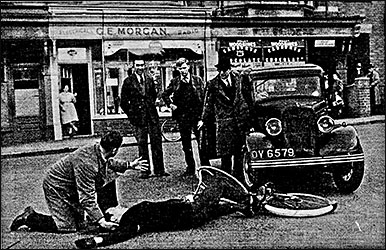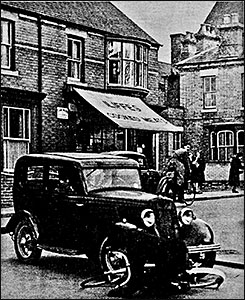|
||||||
| The Rushden Echo and Argus, 10th September, 1948, transcribed by Gill Hollis |
||||||
|
Higham Ferrers and Rushden District Road Safety Committee
|
||||||
|
|
||||||
|
Bicycles parked along the kerb cause danger in Rushden High Street, according to Mr. W. J. A. Peck, a member of Higham Ferrers and Rushden District Road Safety Committee.
When the committee met on Monday, Mr. Peck said that bicycles were often parked in line. Some were pushed over by people with perambulators and lay on the road, where drivers might have to swerve to avoid them. On a recent Saturday morning he saw three fallen bicycles which were obstructing the road. Another member complained that bicycles were often parked in such a manner that people could not use the pedestrian crossings. This occurred regularly near the junction of High Street and Newton Road. Avenue Road, on the Court Estate, is almost a speed track for motorists, according to the evidence of Coun. Mrs. O. A. H. Muxlow. It is a straight mile, and they just scorch along it,” said Mrs. Muxlow. 17th September, 1948 Prams Were the High Street Menace When Higham Ferrers and Rushden Road Safety Committee debated last week the danger of bicycle parking in the High Street, they forgot a similar menace which is precisely five times as serious. So writes an “Echo and Argus” representative who made “anything but a Gallup” survey along High Street one afternoon this week. In a twenty minute walk along High Street, he writes I counted ten bicycles and FIFTY-THREE prams. The cycles, parked along the kerb, were mainly out of the way, but the prams, pushed along like priority battering rams, either took the pavement by storm or barred the progress, sending busy pedestrians scuttling on to the road. At the main cross-roads near the church, number one danger spot on the map of Rushden, seven prams reigned over the pavement – and the mothers were with them having an afternoon chat. Not twenty yards away three more prams, left unaccompanied by ration-hunting mothers were taking up valuable safety space. A van on the opposite side of the road, temporarily parked by a driver going about his business, meant that the part of the street left to traffic and hurrying pedestrians was narrowed down to a few feet. Danger Sign A hundred yards down the road I saw the first sign of the dangerous bicycles – three of them standing on a wide pavement – and as I walked by, a young lady mounted one and rode away. One van and two cars (one parked 1ft. 6ins. from the kerb) were the only other stationary vehicles on the road between the church and the “Rose and Crown” but there was a good quota of perambulating perambulators. One empty pushchair parked in the section near an office caught the wind and set sail on its own. A woman passer-by in a fawn coat paused in her stride to push it up against the wall. She may have averted a nasty accident. Not so “pram-conscious” was the lady who parked a cream and black pram with its handle jutting half-way across the door of a butcher’s shop a little further down the road. Another bicycle was discovered standing outside Messrs. Woolworth’s, but it was not the lone bicycle which might have caused a death. Three mothers and their prams chose that precise spot to wish each other good-day. Workmen were busy with a ladder further down the road, and two pram-pushers met head on. “Coom on gel, give us a chance,” said one. And then they both stopped and talked for a minute. I timed them. While they were engaged, oblivious to the congestion they were causing, another woman, pushing a red-coated baby in a push-chair, had to wander out into the road to pass. Child Was Busy The child, busily blowing up a balloon took no notice. It might have been his last balloon. There were no cycles blocking the crossing near Station Road, and the lady pushing the blue-covered pram had obviously been about to cross when met by two friends. They had reached the baby talk stage before the pram was pulled back on to the pavement. After many good-byes to the baby, the lady went over the crossing. “Well, my dear, fancy seeing you.” She stopped, just off the crossing and right on the corner, for another chat. It did not last long, but long enough to cause a drayman to halt further into the road than was really necessary. It was not really necessary for him to stop his horse right on the end of the pedestrian crossing. Back up the High Street, I found the three bicycles that I looked for, two roadsters and one lightweight – obviously owned by a man of the road, for it carried a spare wheel. All had been blown over by the wind and they did block the pavement. I had no sooner restored two to the vertical when they were claimed with a “Thank you” by their owners. The third refused to stand steadily, so was left recumbent. The survey was made from 4.0 to 4.20 in the afternoon. If the Road Safety Committee members want to check my facts, it only means a short walk. But let’s hope they don’t get caught up by those prams!!! |
||||||
|
||||||

